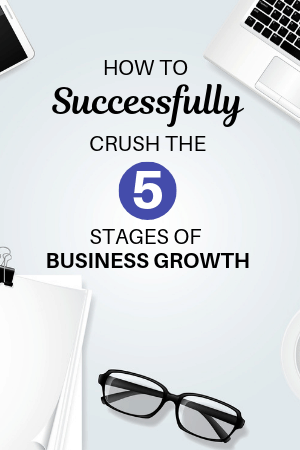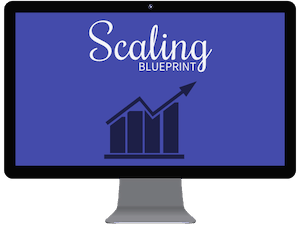If you are a business owner, you’re no stranger to hard work and hustle.
Maybe you were drawn in by the allure of setting your own hours, being your own boss, or working from home in your PJs— only to be hit hard by the cold reality that running a business isn’t as easy as you thought.
Your goal is to grow a successful business that effectively serves your customer base, earns a profit, and allows you to build the life of your dreams (rather than trading your time to build someone else’s).
As the owners of three successful businesses that collectively generate six-figures per year, my wife and I have navigated the stages of business growth several times.
It hasn’t been easy, but we’ve learned several lessons that can help virtually any business owner—brick and mortar or online—accelerate their business growth and experience fewer headaches and hiccups along the way.
In this article, we’ll cover tips to help you successfully work your way through the five stages of business growth, including:
- Vetting a new business idea to ensure it is viable
- Identifying your ideal target customer and market
- Narrowing down how you’ll help solve their unique problems
- Identifying your unique value proposition (what makes you different and stand out among your competition)
- Deploying your biggest resources — time and money — to grow your business
- Developing a growth plan and systems approach
Wherever possible, I will include real-life examples and stories about our business growth.
Let’s get started!

What Are the Stages of Business Growth?
Business growth is a hot topic! In fact, several models of business growth have been developed and taught over the past several decades in an effort to simplify this complicated subject.
Why are there so many different models, you ask?
The complexities and challenges of growing a startup into a lasting business have changed greatly over the past three decades.
For the purposes of this article, we will adopt a model which focuses on the following five stages of business growth:
- Development Stage
- Startup Stage
- Growth and Survival Stage
- Expansion and Rapid Growth Stage
- Maturity Stage
As you’ll see from our examples, each stage presents its own opportunities and challenges.
1. Development Stage
I’ll never forget the initial thrill my wife and I felt when starting our first business.
We researched carefully, asked all the right questions, and created a plan.
We were poised to take what had started out as a way to make extra money on the weekends in college and turn it into our own small business.
Understandably, we were excited!
Of course, transitioning from “genius idea” to viable business was far more difficult than we expected.
At times, we experienced doubt and wondered if we were cut out to be entrepreneurs.
We knew our business model — teaching private music lessons — could be successful, but we had to ask ourselves some tough questions:
- Can our business be profitable in a market saturated with competition?
- How will we effectively market our services?
- Who is our target customer? And how do we connect with them?
- How will we grow and develop this business while still performing well in our day jobs?
Through research and lots of trial and error, we learned several strategies that helped us grow our new business.
Know Your Unique Value Proposition
When you’re starting a new business, the odds are high that someone else is already doing what you’re doing.
But, if you can determine your own unique offer — specialized expertise, a new twist on a familiar product or service, etc. — you’ll be poised to stand out in a crowded market.
As Zig Ziglar famously said…
You can have whatever you want if you help other people get what they want.
My wife and I knew our music lesson business could be built primarily on our youth and ability to connect better with young people than our more seasoned competitors (more on that below), so we took that focus and ran with it.
It worked.
Determine Your Target Customer and Serve Them Well
When we started our music lesson studio, my wife and I could have gone in many directions.
We considered teaching a wide variety of students in virtually every instrument family, but we quickly realized that doing so would push us outside of our area of expertise and diminish the value we could provide our clients.
Ultimately, we narrowed down our ideal customer to elementary and middle school students from the ages of 4-12.
We found that this age group of kids (and their parents) loved working with us, and our business grew organically through word of mouth as a result.
The success of your business development hinges on an understanding of your target customer and how you can solve their problems.
If thinking about this makes your head spin, consider these helpful tips:
- Think about the service or product you provide from your customers’ point of view. Does it satisfy their biggest needs?
- Consider how your ideal customer makes a buying decision. What obstacles, fears, or concerns hold them back? What needs need to happen before they will make a purchase?
- Your ideal customer is someone who will buy from you, not a competitor. What do you need to do to position your product or service to be perfect for them?
The more you know your audience, the more you can succeed.
Your Biggest Commodities Are Time and Money
While getting our business off the ground, we learned a lot about time and money management.
It would have been easy for us to purchase advertising spots in local publications and Google AdWords (this was before the days of Facebook and Instagram ads), but there was one big problem:
We didn’t have any money.
So, we spent the only commodity we had at our disposal — time — and developed our business slowly.
When your business is in the development stage, we recommend the following strategies:
- If you have money to spend, do it — but only if it helps you solve significant problems faster than you can do it on your own
- Break tasks down into small increments
- Do something every day to get your business ready for launch
Bootstrapping your way into the next stage will be difficult, so roll up your sleeves and be ready to work hard.
2. Startup Stage
The sad reality is many businesses never grow beyond the development stage, primarily due to lack of execution.
Much has been written about the startup stage of business growth, but in our experience, getting there is the hardest part. Whether your business reaches this stage is entirely dependent on whether you put in the hard work.
Planning is great, but at some point, you need to start taking action.
Remember, a dream without action is really just a nightmare.
It’s easy to get bogged down thinking about accounting, starting an LLC, and tweaking your product or service until it’s just right. But clarity and focus come from getting started and doing the work.
As business expert Stu McLaren once said…
You may not be clear on where you’re going, but you have to keep moving.
3. Growth and Survival Stage
The biggest lessons I have learned about the growth and survival stage of business growth have come from my second business, a personal finance blog called FinanceSuperhero.
In the interest of full transparency, I still feel like my business is in this stage most days — though occasionally it feels like I’m turning a corner and entering the next phase of business growth.
After muddling through a lengthy development and startup phase, it felt like a huge accomplishment when my business generated a profit and experienced month-over-month growth.

Then my son, Joshua, was born, and navigating the growth and survival stage of my business was put on my mental backburner.
Why?
There were many reasons, but the overall problem was simple:
I had not taken the time to fine-tune my business by putting systems into place.
I stopped implementing a content strategy and editorial calendar altogether and more or less produced new content when I felt inspired. For example, one week, I wrote a post on legitimate ways to get free money, and then I didn’t write another post for weeks.
Not good.
You Need a Plan
Furthermore, I didn’t have a solid plan to actually grow my business at this time.
I was mostly throwing spaghetti at the wall to see what stuck.
Don’t get me wrong. Testing new strategies and consistently implementing what works can be a great growth strategy, but it’s one piece of the puzzle.
Moving beyond survival and scaling your business can often be done more effectively by spying on your more successful competitors and implementing their success strategies in your growth plan.
In other words, you don’t need to reinvent the wheel.
Here are a few more lessons I have learned the hard way about moving beyond the growth and survival stage of business growth:
- It can be tempting to throw money at your problems at this stage. This can be wise, but if you’re not growing the gap between expenses and revenue, you’re not really growing.
- Successful scaling almost always requires more help. Dragging your feet on outsourcing will hold you back, and it’s delaying the inevitable (Yes, I’m writing this as a reminder to myself as well!)
- Be patient! Growing your business will take time — likely hundreds or even thousands of hours — and progress will be slow at times.
Aim for growth in the long-term and your priorities will stay aligned to your goals.
4. Expansion and Rapid Growth Stage
Remember that third business I mentioned earlier?
I’m a musician, blogger, and — drum roll, please — a real estate agent.

I have been blessed to work with a wonderful partner who is even more of a go-getter than I am, and our business has skyrocketed since we started working together.
Recently, we added a third team member to the mix, which puts us squarely in the expansion and rapid growth stage of business development.
It has only been a few months since we reached this level, but we’ve quickly learned that this stage is all about capturing greater market share, moving into new markets, and expanding our presence.
Collectively, we have our sights set on becoming a major player in our area in the next few years.
We want to help more families buy and sell and complete 100 transactions or more per year. (The average real estate agent sells around 12 homes per year, to put our goal in perspective.)
Of course, this type of rapid growth will require refined strategy, increased ad spending, and more efficient processes to convert leads into clients and transactions.
Here are a few more tested strategies to rapidly grow your business:
- Seek funding or equity investment from new partners to infuse more cash into your business.
- Refine the strategies and processes that got your business to this stage. If you’re not sure what to do next, hire a consultant who specializes in this area.
- Ensure that all new team members share your vision for growth.
- Don’t be afraid to establish lofty goals.
Keep us posted in the comments below on where you are in the stages of business growth and what you’re doing to grow your business!
5. Maturity Stage
Wouldn’t it be amazing to reach the pinnacle of accomplishment with your business? To dominate the competition like the Amazons, Apples, and Nikes of the world?
Of course!
Most entrepreneurs hope to reach this stage and become one of the major players in their business niche.
That said, the process of getting there is incredibly challenging and loaded with significant risks, including burnout, stagnation, and loss of direction.
You may even be thinking of stopping.
The key question to ask yourself at this stage of business development is simple…
How do you stay on top?
The answers will obviously vary from business to business, but generally, the following guiding principles should help you maintain razor-sharp focus:
- Accept that the growth of your business will slow down significantly at this stage.
- Be on the lookout for ways to maintain the same emotional edge and energy that helped you grow your business to this stage in the first place. For example, it could be time to branch out into new products or services to keep your team challenged and focused on new goals.
- Accept the fact that you probably won’t be able to have your hands in every aspect of your business at this stage and trust the team you’ve built.
One more word of warning…
If you cannot disengage enough to trust your team or become severely unmotivated during this stage of business development, it might be time to start considering an exit strategy.
Conclusion
I hope this post has helped you consider the challenges and opportunities of navigating the five stages of business growth.
We’ve looked at each stage of business growth from a high-level perspective and examined real-life strategies to help you successfully progress through each stage.
Here’s a reminder of what they are:
- Development Stage
- Startup Stage
- Growth and Survival Stage
- Expansion and Rapid Growth Stage
- Maturity Stage
Whether you’re considering starting a business of your own or seeking to grow an existing business, know that there is no such thing as an overnight success.
Say it with me…
This is going to take time.
Again, I hope you feel better prepared to grow a business and tackle the challenges of each of the stages of business growth.
I’m rooting for you!



